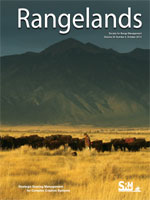On the Ground
Landscapes are complex creative systems that are endlessly emerging, transforming, and vanishing as a result of ever-changing relationships among organisms and environments—soil, plants, herbivores, and human beings. In the process, all organisms are actively participating in creating environments; they aren't merely adapting to them.
Researchers and managers attempt to understand and manage creative relationships among soil, plants, herbivores, and human beings, but we have become increasingly separated from one another in our endeavors. When we work in partnerships, we can better learn about biophysical processes and participate in managing as landscapes continually create.
To do so, researchers must combine their reductionist thinking and intent to develop “best management practices” with new approaches that consider creative systems. In turn, managers must come to appreciate the value of “reductionist” research for understanding processes and developing principles that apply generally across time and space.
The challenges we face in addressing “critical issues” have little to do with the issues and much to do with crossing the divides that polarize and isolate us. The irony is that working together to transcend the boundaries we create is addressing the “really big issue.”





